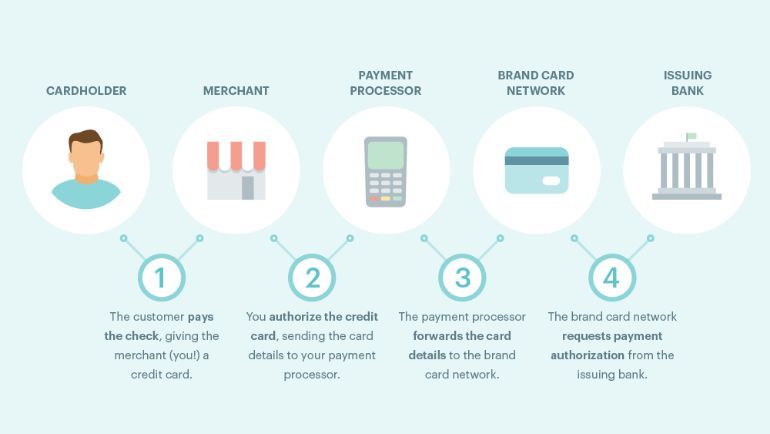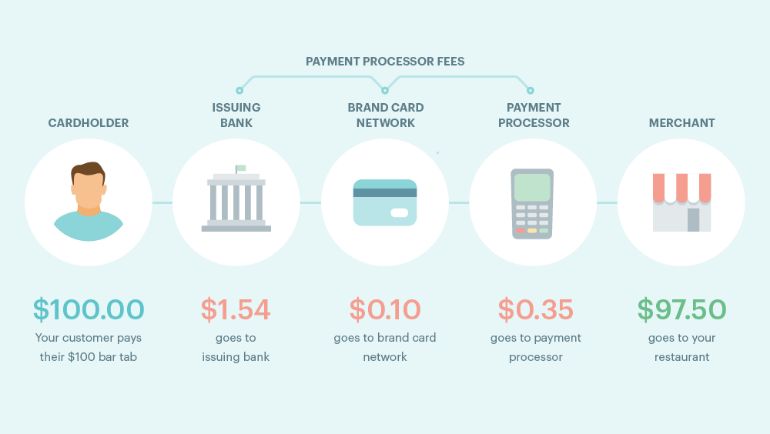Payment processing for restaurants is a timely topic because people are using non-cash options now more than ever before when they dine out.
With so many other, more secure, connected, and convenient payment options available, walking around with cash seems unnecessary.
In fact, TouchBistro’s 2023 Dining Trends Report and 2023 State of Restaurants Report found that:
- 86% of Canadians and 77% of Americans prefer to use either credit or debit cards when dining in at restaurants.
- 66% of restaurants accept mobile payments, 63% of restaurants accept credit cards, and 38% of restaurants accept debit cards.
- While 84% of restaurants accepted cash in 2019, that figure has fallen to 69% in 2023.
The bottom line is: if you only accept cash at your restaurant, you could fall behind the competition. If you’re curious about your other options, you’ve come to the right place. We’re breaking down everything you need to know about payment processing for restaurants, including:
- What a payment processor is
- Who’s involved in a single transaction (the main players)
- How payment processors decide rates
- Pricing models
- Aggregators vs. merchant account providers
- Integrated vs. non-integrated payment terminals
Yep, we’re covering it all. Ready? Let’s dig in!

Find out which fees are negotiable and how to get the best price.
Payment Processing for Restaurants: What Is a Payment Processor?
If you want to accept credit, debit, and digital payments, you need to partner with a payment processor, also known as an acquirer.
These companies provide merchants like you with payment terminals: the hardware that allows you to accept credit cards, debit cards, and digital payments. They become the middle person between the diner, restaurant, credit card network (e.g. Visa or MasterCard), and issuing bank. Part of the restaurant payment processor service is to clear and route the transaction, then deposit money into your account.
In exchange for the services they provide, restaurant payment processing systems charge a fee. Rates vary among companies, but are typically calculated per transaction. Some payment processors also add a fixed dollar amount per transaction.
The Players of Restaurant Payment Processing
If you’re thinking that’s a lot of different parties involved in one simple transaction, you’re right on the money.
Here’s a quick glossary to help you keep track of the major players, which we’ll be referencing throughout this guide::
- Merchant: The business accepting the payment (e.g. the restaurant owner)
- Payment processor: The company that provides the payment terminal, clears and routes each debit and credit card transaction, and deposits the money in the merchant’s account
- Card brand network: Credit or debit card companies (e.g. Visa, MasterCard, American Express) that control where credit cards can be accepted and facilitate transactions between merchants and credit card issuers
- Issuing bank: The financial institution that issues credit and debit cards to consumers (e.g. Chase, Bank of America, TD Canada Trust)
How Payment Processors Decide on Rates
Restaurant payment processing systems consider many factors before they give you a custom rate.
You can expect payment processors to assess your industry, your business and credit history, and your projected or established sales volume as part of the rate-selection process. Lower-risk, higher-volume businesses will usually have lower rates than restaurants that are just starting out.
For use of their services, restaurant payment processors charge three types of fees: flat, situational, and processing.
1) Flat Fees
Payment processors charge flat fees, which may include line items like:
- Annual fee
- Batch fee
- Monthly fee
- Network access fee
- Online reporting fee
- Payment gateway fee
- Statement fee
- Terminal fee
It’s important to review flat fees before you sign a contract with a payment processor to ensure you know what you’ll be paying each month.
Some of these fees are negotiable, so it’s important to go through them carefully before signing anything. Make sure you compare with other acquirers’ fees to ensure you’re getting the best price possible. Some companies charge flat fees for features you may not use (i.e. paper statements) or charge lower, percentage-based processing fees (see below), but bury some additional costs in these fixed fees, so it’s worth looking at the breakdown before signing.
2) Situational Fees
Restaurant payment processing companies also levy charges “per event,” which means when a specific action happens, including:
- Cancellation fee
- Chargeback fee (non-negotiable)
- International fee (non-negotiable)
- Liquidated damages fee
- Monthly minimum fee
- NSF fee (non-negotiable)
- Set-up fee
Some of these fees are negotiable. Ask yourself: How does my business operate? How many of these events happen in any given month? Then use your answers to compare flat and situational fees between restaurant payment processors to help you find the right fit.
3) Processing Fees
These fees make up the bulk of what you pay a payment processor – they have the most variables and are calculated on each transaction.
What’s Involved in a Credit Card Transaction?
When a diner pays their restaurant bill by credit card, it looks a lot like a simple transaction between them and the restaurant. Chances are, your customers are blissfully unaware that multiple entities are involved (and getting paid) every single time they use their credit card.
Here’s a look at the processing fees and credit card fees happening behind the scenes with every transaction.

Each step of the transaction is associated with a processing fee, usually a percentage. The payment processor is responsible for paying these fees to the corresponding major player.
To cover these costs, plus their own, the processor charges the merchant (that’s you) an overall processing fee that’s made up of three different types of fees:
- Interchange fee: Every credit card network (e.g. Visa, Mastercard, etc.) charges merchants a percentage-based interchange fee every time a cardholder uses their credit card. It’s the cost of authorizing the charge. The interchange fee for a debit card is much less than for a credit card.
- Card brand fee: Every transaction, no matter what type of card, is also subject to a small, percentage-based fee paid to the card network for each transaction.
- Payment processor markup: Some payment processors apply a percentage-based or flat (or a combination) markup fee for routing money from the cardholder to the card brand network to the issuing bank.
Let’s look at an example of processing fees for a $100 restaurant check.

In this scenario, the restaurant pays $2.50 of a $100 check in credit card processing fees.
Your payment processor will filter and summarize all of these rates and fees and you’ll see them as part of the processing fees on your monthly statement.
The Nuances of Payment Processing Rates for Restaurants
While merchants can’t negotiate a credit card’s interchange rate, there are three variables that come into play when payment processors set processing rates for restaurants and other businesses:
1. Type of Credit Card
Not all credit and debit cards are created equal. A student credit card with a low limit will have a lower processing fee than an international business card with plenty of perks.
The rate is also dependent on the brand of the card. For example, American Express tends to have higher processing rates than other brands.
2. Type of Payment
As a restaurant owner, you can choose to offer many credit and debit payment types. Here’s how to accept credit card payments:
- Manual: The server manually enters the credit card number.
- Swipe: The customer swipes their card in the terminal and signs the receipt.
- Dip and sign: The customer inserts their card into the terminal and signs the receipt.
- Chip and PIN: The customer inserts their EMV chip card into the terminal and enters a PIN to complete the transaction.
- Tap: The customer taps their EMV card on the terminal – no signing or PIN required.
- Digital Payments (Apple Pay, Google Pay, Samsung Pay): The customer uses their phone to authorize a restaurant mobile payment by hovering their device over the terminal.
Generally, the more secure the form of payment, the less expensive it is to offer. For example, swiping cards through credit card readers costs more per transaction than mobile payments because the former is more open to fraud.Similarly, EMV chip cards are more secure than traditional debit or credit cards, and are cheaper to process.
There are also security-related charges involved with taking orders over the phone, often called a card-not-present transaction. Card-not-present transactions carry a higher risk of fraud, so offering this kind of payment costs more.
3. Type of Retailer
Rates can also vary by business types.
In most cases, larger merchants have lower rates because they process a higher transaction volume and are able to better negotiate with credit card companies. This means that a big-name restaurant brand will have a lower interchange rate than a small, independent venue because that restaurant has a lower transaction volume.

Find out which fees are negotiable and how to get the best price.
Payment Processing for Restaurants: Pricing Models 101
Processing fees depend on many factors.To simplify pricing and offer merchants transparency, most restaurant payment processors use one of four pricing models:
- Cost plus
- Interchange differential
- Flat fee
Cost Plus Payment Processing for Restaurants
Also known as Interchange Plus or Interchange Pass-Through, this model makes the merchant responsible for the non-negotiable interchange fee and the payment processor’s markup . This markup consists of a fixed percentage of the total check, the card brand fee, and a flat per-transaction fee.
Interchange fee + % of total check + card brand fee + transaction fee = total processing fee
Here’s an example:
Let’s say a restaurant payment processing system charges a 1.54% interchange fee, 0.10% of the total check, and a 0.10% card brand fee, plus 25 cents per transaction.
1.54% + 0.10% + 0.10% + $0.25 = 1.74% + $0.25 total processing fees
For a $100 restaurant check:
($100 x 1.74%) + $.025 = $1.99 total processing fees
Flat Fee Restaurant Payment Processing
Under the flat fee or “fixed rate” pricing model, a restaurant payment processing system will charge a percentage-based fee plus a dollar amount for each transaction. This pricing model is extremely simple and allows merchants to know exactly what to expect when it comes to transaction fees.
% of total check + transaction fee = total processing fee
Here’s an example:
Let’s say a payment processor charges 2.75% of the total check plus a 25-cent transaction fee per transaction.
2.75% + $0.25 = 2.75% + $0.25 total processing fees
For a $100 restaurant check:
($100 x 2.75%) + $.025 = $3.00 total processing fees
Interchange Differential Restaurant Payment Processing
You know that each credit card has its own interchange rate set by each credit card company, and that these rates change slightly based on the type of card (i.e. a basic student card vs. a premium platinum card).
The interchange differential pricing model uses the difference between these card-type-based interchange rates as the basis for their pricing. For every transaction, you pay the interchange rate, non-qualified fee (if it’s above a basic card or a CNP transaction), card brand fee, and an interchange differential fee.
This model requires restaurant owners to have a good handle on the types of cards their customers typically use.
Interchange fee + non-qualified fee + card brand fee + interchange differential fee = total processing fee
To break it down for you, here’s an example:
Let’s say a payment processor charges a 1.54% interchange fee, 0.35% non-qualified fee, a 0.10% card brand fee, and a 0.22% interchange differential fee.
1.54% + 0.35% + 0.10% + 0.22% = 2.21% total processing fees
For a $100 restaurant check:
$100 x 2.21% = $2.21 total processing fees
Aggregators vs. Merchant Account Providers
Now that you understand what payment processors do, how they decide their rates, and what pricing models exist, consider whether you should use a restaurant payment processing company that operates as an aggregator or a merchant account provider.
Aggregators
An aggregator is a payment service provider that registers merchants (like your restaurant) directly under its own merchant ID number and processes payment transactions through a single master account.
Aggregators are a popular choice for small businesses that process a low volume of transactions because they provide a streamlined payments solution and charge a flat fee per transaction.
The main benefits of using an aggregator are predictable pricing and a simple, fast application process, which means you can start accepting credit card payments quickly and easily.
Merchant Account Providers
Larger or higher-volume businesses may do better with a merchant account provider, which assigns each business a dedicated merchant ID.
A merchant account provider also provides the hardware to accept payment, and offers more customized service with a representative assigned to your business.Merchant account providers can track and provide protection that helps prevent any interruptions. They usually operate under a cost-plus pricing model.
Integrated vs. Non-Integrated Payment Terminals
Another consideration when choosing a restaurant payment processing system is an integrated payment solution or a non-integrated solution.
In the simplest terms, an integrated payment solution speaks to your POS, while an unintegrated payment solution doesn’t.
Integrated Payment Terminals
When someone makes a payment in your restaurant when you have an integrated payment terminal, your POS automatically syncs this information to your payment terminal, prompts the customer to make the payment, and then automatically communicates this back to your POS to complete the sale – a seamless process.
This direct communication simplifies and speeds up your accounting processes, and eliminates the risk of human error.
Non-Integrated Payment Terminals
If you’re using non-integrated payment terminals and a customer goes to make a payment, your counter staff or server has to manually enter the check amount into the terminal and print a receipt for your records.
The staff member then has to manually mark the purchase as paid and record the sale in your POS. You have to hope they punch in those numbers correctly every time, because even small data entry errors could cost you.
With these risks in mind, more and more restaurant owners are looking for the convenience and effectiveness of integrated payment systems.

Find out which fees are negotiable and how to get the best price.
Finding the right restaurant payment processor for your business, like one that integrates with your POS, will help you deliver a great customer experience while saving you time and money. We hope that with the help of this complete guide, you’ll be well equipped to enter a perfect payments partnership.
Learn how to save money on payment processing fees
Sign up for our free weekly TouchBistro Newsletter







